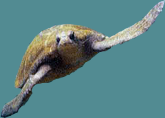Introduction to Agriculture on the Galápagos
Agriculture has a long history in the Galápagos islands. First popularized while the islands served their time as a penal colony, agriculture has since served as a key aspect of the Galápagos economy. (Constant, 2004) Today it provides one of the most significant opportunities to redress many pressures facing the islands, particularly those associated with invasive species, immigration, and exploitative resource use.
In 1979 the Ecuadorian government passed Inter-Ministerial Agreement number 0297, published in Office Registry number 15 on July 31st, which among other things set aside 60,314.14 acres (24,408.8 hectares) of land for agricultural purposes in Galápagos. As recorded in the World Heritage Nomination, the Galápagos National Park (GNP) covers 18,940,874.6 acres (7,665,100 hectares) which implies that 3.17 percent of all land in Galápagos has been used in agriculture. (IUCN, 2001) While this may seem like a reasonable figure, each of these agricultural zones lie within the humid region on their respective islands and so have a particularly significant impact on biological diversity. (Kerr et al., 2004)
| Island | % humid region cleared | Agricultural Land (ha / ac)
|
| Santa Cruz | 74 | 11,448.30 / 28,288.75
|
| Floreana | 15 | 7,892.60 / 19,502.61
|
| Isabela (Sierra Negra) | 14 | 4,783.10 / 11,819.04
|
| Isabela | 8 | 4,783.10 / 11,819.04
|
With the advent of the fishing economy, much of this land was abandoned as its economic value was marginalized when compared with profits gained through exploitative use of marine resources. (Ley, 2002) Plots left open in turn became havens for introduced species to fill an otherwise vacant niche. (Tye, 2003) By 2001, more than 600 introduced plant species were identified on the islands with particularly high concentration level in and surrounding these agricultural zones. (Falconí, 2001) Attempts to deal with these species have thus far been only marginally successful, incredibly successful, and generally compromised by a continuing influx of new species from the mainland.
Under the Special Law, regulations governing agriculture receive limited attention. The law advocates the eradication of invasive species and the establishment of sustainable agriculture on the islands and optimization of land use, but does not provide suggestions as to how such initiatives should be implemented. With Article 58, the law bans the “spraying, introduction, selling, or [use] of pesticides and agrochemical products classified as extremely and highly toxic.” (Special Law, 32) Chemicals currently used in agriculture on the islands include (recorded using their Spanish name)
1:
| Purpose | Chemicals Used
|
| Protection of the plants from fungal infections. | Maneb, Clorotalonil, Azufre microinizado, Fungicidas Sist?cos, Azoxistrubina, Mancozeb + Hidroxido de Cobre, Hidro de Cobre, Sulfato de Cobre Pentahidratado, Mancozeb + Metalaxil
|
| Selective herbicides | Paraquat, Glifosato, Picloran, 2 4D Butil Amina Insecticidas de contacto e ingesti Lamdachalotrina, Carbaryl, Malathion, Abamectinas, Diafenturion, Acetamipiris
|
| Productos fijadores | Agral - Aceite
|
Farmers also use ergostin as a biologically friendly means of stimulating plant growth and Stumifol and Fertipac to fertilize the plant’s leaves. These products are used both to promote crop resilience and to eradicate weeds and other pests that are seen as posing a threat to a farmer's fields.
The CDF in conjunction with the Ministry of Agriculture and Cattle Raising as well as the Galápagos publishes lists of plants, which may not be grown on the islands. These include
2:
- Primary Crops: Corn, Beans, Peas, Potatoes
- Fruits: Tree tomatoe, Orange, Papaya, Clementine, Lemon, Mandarin, Banana, Plantanel, Pineapple, Avocado, Cherimoya
- Vegetables: Celery, Beets, Garlic, Lettuce, Cabbage, Spinach, Coliflower, Broccoli, French Green Bean, Radish, Carrot, Coriander, Melon, Watermelon, Cucumber, Zuccinni
These regulations have been established in an attempt to address the number of introduced species associated with agriculture on the islands.
The introduction of cattle, goats, donkeys, and horses that have escaped from farms and turned feral has arguably had the most dramatic impact of any agricultural activity on the island. On Isabela, over 25,333 feral goats and 688 burros were killed in 1996 along after huge populations succeeded in decimating most of Alcedo Volcano. (Cayot, 1998) Similarly, the vegetation of Santiago was decimated by a large feral pig population that has recently been removed from the islands. (Falconí, 2001) In each case, these large herds of animals have necessitated large-scale investment of capital, time, and skill to eradicate leaving in their wake tremendous devastation.
Many factors currently limit agricultural production on the islands. Beyond the list of species banned from production, limited water resources, poor soils, lack of organization among farmers, and poor marketing strategies impinge upon the success of agriculture on the islands. (Kerr et al., 2004) While many NGOs on the Galápagos have been working with a sustainable vision in mind, there is little evidence to suggest that these efforts are having a substantial positive impact
3.
[top]
A Sustainable Vision for Galápagos
We have envisioned a Galápagos where all residents have a job within the community that links them directly to the ecological health of the islands. We view it as essential that each person takes ownership of the project of conservation, and it is in agriculture that we encounter a unique compilation of leverage points beneficial to a realization of this potential. Agriculture provides a unique educational tool, means of establishing a stable and strong community and economy, regulating and redressing damage associated with invasive species, restoring natural ecology, and incentivizing against natural resource exploitation.
[top]
Agriculture in Galápagos
The ideal farming strategy for the Galápagos revolves around a combination of organic and biodynamic farming methods. The advantages of both organic and biodynamic farming includes improved soil quality and water retention, a chemical, pest and disease free growing environment, increased yield per unit area, and higher vitamin and mineral content in crops grown under standard conditions3. (Pfeiffer, 1983)
Volcanic soil provides an inherently rich chemical base that can be transformed to provide incredible nutrient caches with appropriate cultivation. (Amien, 1998)For example, volcanic soil tends to be too basic for most crops currently planted on the islands and so becomes a much more useful agricultural base if mixed with organic matter removed from the composting cycle a few months early. (Todd, 1993)
Composting is a key component of both organic and biodynamic farming. This is particularly true in areas where the soil start out with a high porosity, as this quality limits the soil’s capacity to retain water and release nutrients for plant uptake. (Werner, et al., 2004) As a result, the use of a range of composting processes will be necessary to enrich and enlivening the soil. This will be particularly essential during the initial transition from present practices to our end vision, while forever remaining an integral part of sustainable agriculture to a lesser degree. Specific methods include the production of solid composts and compost teas
4. Currently, organic wastes on Santa Cruz make up 60% of total waste, while this number rises to 70% on Isabela and 72% on San Cristobal. (Ley, 2002) Food scraps fish remains, and other organic waste in combination with agricultural by products will be used in the creation of these composts. Composting pits will be located along the edge of each field. Each farmer will be responsible for his or her own compost production, but a single farmer could also agree to dedicate a portion of his land solely to the production of early stage compost and then sell this to his peers as a means of augmenting his income. Turnover time for composts, particularly in warm regions such as Galápagos will be between six months and a year. (Ingham, 2001)
Both biodynamic and organic farming require a deep understanding of the crops planted and land used, particularly in situations where the initial conditions are unfavorable to farming. While this may appear a detriment to the potential inherent in sustainable agriculture for Galápagos, it also provides a significant asset. One of the greatest challenges involved in village design is the creation of a system that instills a sense of pride and success in the villagers. By asking them to appreciate the relationships between soil composition and plant health, plant type and compost content, and field layout with water retention, agriculture is no longer seen as employment for the uneducated. Current water resources are as follows:
Water Usage
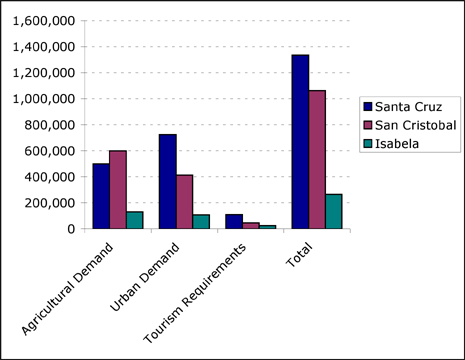
(Ley, 2002)
Perhaps one of the most significant benefits of biodynamic and organic farming on Galápagos is the manner in which it deals with pest infestation in crops as well as diseases. In many instances the pests or plagues associated with a particular crop are introduced to the islands and thus pose a significant threat should they propagate. Using pesticides and agrochemicals to deal with these threats can lead to mutation within these different genetic pools, thus creating a population that requires even more toxic applications to deal with the threat. (Arthur, Barefoot, & Clay, 2003) While few specific examples of such mutation are available for the Galápagos, innumerable studies have shown that particularly virulent insects, molds, and diseases develop immunity to the toxic sprays often used to destroy them, in turn breeding a pest unaffected by the pesticides application. While worldwide pesticide use since 1945 has risen more than 1,000 percent, crop devastation on average due to pests and diseases has doubled. (Saunders, ) Should these secondary strains move into the island ecology more generally, the threat associated with non-native species will expand to include those pests strengthened through the application of pesticides. This dilemma is an unnecessary problem in biodynamic or organic farming where crops are adequately healthy such they become unsuitable hosts for such pressures. (Pfeiffer, 1983)
As just mentioned, biodynamic and organic farming both possess the advantage of producing stronger, more prolific plants. By producing composts containing the nutrients best suited to the plant or pants under cultivation, these methods assure that the crop grows at maximum capacity with maximum voracity. In studies comparing the composition of plants raised using biodynamic techniques and those using conventional methods, it was found that the first group contained an between 56 and 79% more vitamins and minerals per unit leaf mass than the second. (Pfeiffer, 1993) Beyond being substantially pest resistant, these foods provide the nutrition we look for in our daily meals, and will thus improve health on the islands.
[top]
Market Value Adjustments: Stable and Diverse Economy
Currently products grown on the islands cannot compete with produce flown in from either Quito or Guyaquil. Due to mass production methods and cheap labor, imported produce currently costs one quarter as much as local crops. For sustainable agriculture to take hold, this must change. There are multiple options to encourage this shift. First, import limitations should be placed. These can either be achieved in the form of a tariff or flat restriction justified by the risk importing such products presents to the islands.
Another potential market option would be to require that tour operators purchase all the fruits and vegetables they need while in the Marine Reserve from local growers. If this produce is grown bio-dynamically, this option could prove both an advertising tool for these companies and a means of strengthening and diversifying the local economy. To provide a stable market for produce, each common space in each parallel of the village is equipped with space for a market and space for communal dining or private restaurant. Additional market space will be provided in the village center in the three primary villages.
Here it is necessary to examine the effect this rise in product cost would place upon the resident population. According to current estimates, almost every farmer on the islands has land and would thus benefit from the rise in cost
5. Additionally, the added income generated from his or her crops would then go to offset the higher cost of other goods. Where this becomes a real problem, crops could be traded as opposed to purchased using currency. As those farmers with smaller plots of land would potentially have more time to spend working in other areas, income could be well distributed. While this pressure would exist, it would also serve as a slight disincentive for mainland immigration to the islands if cost of living were to increase.
An additional avenue for development would be to have the farmers cultivate endemic species of plants as opposed to products to sell in an agricultural market. The CDF or GNP could then repatriate these young plants to regions where their numbers have fallen drastically due to some threat associated with the presence of the human population on the islands (particularly invasive species, diseases, or changes in the island’s ecology due to human presence). Where endangered species are not available for such cultivation, endemic softwood trees could also be grown by the farmers and then sold to the carpenter and ocean pickup designers for their construction. Of course any of these options present two potential areas of unwanted impact: one would be the harvesting of endemic species from uncultivated areas should a market be established, and second would the disruption of the natural distribution of endemic species and subspecies if these fields are not carefully controlled.
There is also a range of mixed use farming proposals that could be used to both restore the ecology of the humid zone and to improve crop performance. As mentioned above, endemic softwood tree species provide an exceptional potential crop. Rather than dedicating an entire field to their cultivation, these fast growing trees can be planted along the boarders of the fields or integrated within the field itself. These trees then help improve soil water retention from its current degraded state.
Should such designs gain momentum, it would be essential that zoning regulations be strictly enforced to ensure that farmland does not expand. We do not want to shift natural resource exploitation patterns away from fish and to fields only to find ourselves backed into a similar corner.
[top]
Labor
A misconception associated with farming on the islands is that there is a severe labor shortage. This was first brought up as an issue when farmers decided it would be more profitable to fish than to farm and so called on those looking for jobs on the mainland to come to the islands to work their fields. This choice, still made regularly today, puts workers in charge of fields who understood very little about the particular constraints of agriculture on the islands, and so were much less capable of identifying invasive species or limiting fertilizer use. In the report Migration and the Environment in the Galápagos, it states as fact that a “limited labor force for … agriculture is crucial as a potential driver of migration because islands [because] owners of farms in the rural area of Bellavista on Santa Cruz affirmed that residents are not interested in working in agriculture.” (Kerr et al., 2004) We propose that if agriculture were restructured in such a fashion that it has a comparable if not greater economic and social draw than fishing, that this issue of interest would be self-correcting.
The decision to leave the agricultural highland villages where they are was made in an attempt to address this question directly. Not only did we believe that it would be impractical to ask there people to move, but the time and energy investment needed to move people from the central villages to highlands and then back to work in the region they presently inhabit would be counter productive if not deadly to our over all vision. By leaving these villages in place we hope to establish a strong farming community. Currently, most families in the three port villages own land in the highlands. If it is worked cooperatively, and if the rising generation is employed in this effort, we believe there should be adequate help to avoid having to call on external assistance. Indeed, if this were to be necessary, we believe a careful analysis would need to be performed to determine whether it would not prove to be more beneficial to begin a process of restoration in those farmlands farthest from the port villages, and in the case of San Cristobal closest to the lake Poza Colorada. (See below for additional information on restoration potential)
[top]
Education and Monitoring
Biodynamic and organic farming both succeed best when the farmers understand the biological processes and cycles essential to crop prosperity, particularly those that regulate health and disease within such an ecological system. While this sort of education is not something that can be learned in a single sitting, it is a knowledge that is directly re-enforced by experience in the field.
As part of this process, farmers will need to learn how to draw samples from their fields to run soil content analysis for comparison over time. By asking them to monitor and record microbial activity, pesticide levels, and mineral content they will be given a very real connection to the workings of a lab, which in turn will foster a sense that they are active members of the educated and important research community while also providing invaluable information about the land on which these crops are being produced. As the farmers will already be in their fields, asking them to draw and record samples will not add any excess pressure to the spaces in which the work. To ensure accuracy while these individuals learn to draw these samples we suggest that the instructors collect and analyze samples from the same sites the farmers do until results correlate consistently. For the purpose of this proposal, and as is fully articulated in the proposal on soil monitoring, sources of particular interest include all spring heads that originate in a farmer’s field and all points where freshwater crosses the boundary between farm and park lands. Of course standard soil samples taken within the boundary of each field would also be necessary for use in agricultural planning. Where the farmers do a good job working their fields, these samples will provide them a sort of hard evidence that will do much to inspire their further interest.
Current water resources on the islands:
Hyrdology of Floreana
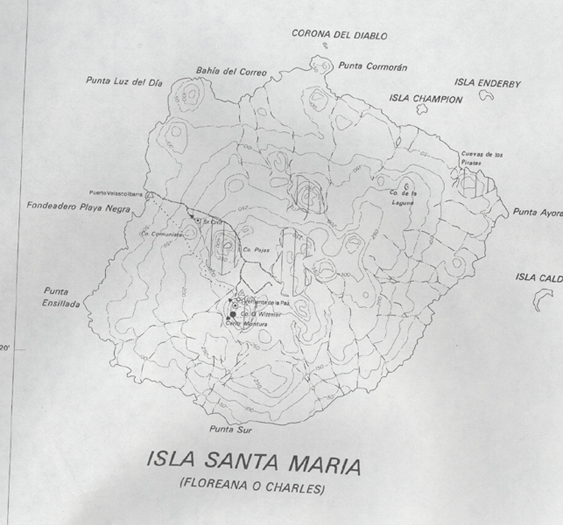
(INGALA, 1989)
Hyrdology of Isabela
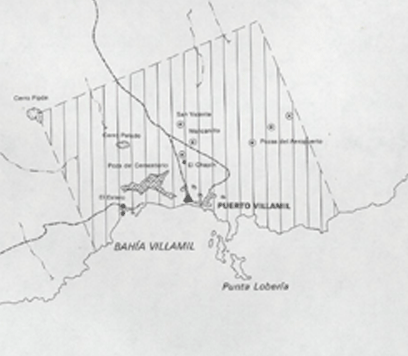
(INGALA, 1989)
Hyrdology of San Cristobal
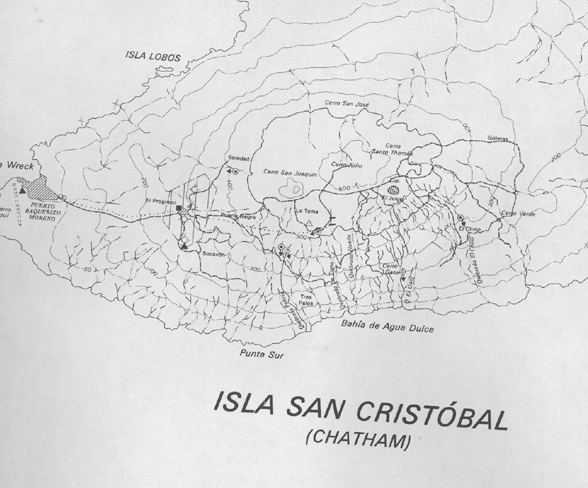
(INGALA, 1989)
[top]
Other options: Ecological Restoration
The process of ecological restoration, particularly the questions of where, how and why to achieve it, are ones that would require a much deeper understanding of the ecology and social structure on the islands than has been achieved during the few months that this report has been drawn together. This acknowledged, we see a range of potential points of intervention, all of which provide a unique and potentially invaluable opportunity if engaged appropriately.
The most eminent of such opportunities is the potential for the park service to purchase agricultural land on San Cristobal where farmers are reported to be less interested in agriculture than many sustainable farming devotees would hope. (Kerr et al., 2004) While we expect that this attachment to land and the process of cultivation can be greatly improved through sustainable agriculture and shifts in market forces, before this shift takes place it could be of great advantage to try and expand the buffer zone around the park zone on San Cristobal. Should such a plan seem feasible, as is suggested by the following data, a corridor between the larger encompassing park region and internal park zone would be an impressive and significant first step towards reclaiming some of the humid region on San Cristobal. While it may appear that such a suggestion undermines the future capacity of the islands to produce adequate food to sustain the population, the following analysis seems to suggest that more land is currently under cultivation than is necessary, particularly given current restrictions on crop choice and soil quality:
| Island | Land Cultivated | Space/person6 | Need/person | Restorable Space
|
| Santa Cruz | 11,448.30 ha / 28,288.75 ac | 1.14 ha / 2.83 ac | 0.445 ha / 1.1 ac | 6996.6 ha /17,288.75 ac
|
| San Cristobal | 7,892.60 ha / 19,502.61 ac | 1.57 ha /3.9 ac | 0.445 ha /1.1 ac | 666.7 ha /14002.6 ac
|
| Isabela | 4,783.10 ha / 11,819.04 ac | .20 ha /2.95 ac | 0.445 ac /1.1 ac | 3002.4 ha /7,419.04 ac
|
For those who believe purchasing land from farmers will be a difficult task, we suggest that a range of incentives, discussed below, could make this option a mutually beneficial one for both parties involved. The above numbers clearly demonstrate that as much as 64% of all land currently considered to be agricultural could be restored without infringing upon the success of sustainable agriculture on the islands.
To complement the repurchase of agricultural land, we present a range of options for moving some agriculture from the highlands to the three primary villages and other less delicate ecological zones. Living Machine technology has been designed in such a way that it functions both as a water purification process and localized farm. (Todd, 1993) Scaling the living machines such that the water purification process is an integral aspect of the landscape between parallels would both augment design efficiency of waste and allow for small-scale agricultural integration directly in the more ‘urban’ centers.
[top]
Sources
- Amien, Istiqlal (1998). Ecological Analysis for Agricultural Development in Indonesia. Jalan Juanda: Bogor, Indonesia.
- Anonymous (2001). World Heritage Nomination – IUCN Technical Evaluation.
- Arthur, E., Barefoot, A., & Clay, v. (2003) Terrestrial Field Dissipation Studies: Purpose, design, and interpretation. American Chemical Society: Washington, DC.
- Cayot, L. (April, 1998). Noticia de Galápagos No. 59 (The Isabela Project, Off and Running). CDRF: Quito, EC.
- Constant, P. (2004). Galápagos: A Natural History Guide. Odyssey Publications: Hong Kong, China.
- Falconí, C. (2001). Galápagos Report 2000-2001. Trama: Quito, Ecuador.
- Ingham, Elaine (2001). The Compost Tea Brewing Manual: Latest Recipes, Methods, and Research. Soil Foodweb Incorporated: Corvallis, OR.
- Kerr, S., S. Cardenas, and J. Hendy (2004). Migration and the Environment in the Galápagos: An Analysis of economic and policy incentives driving migration, potential impacts from migration control, and potential policies to reduce migration pressure. Motu Economic and Public Policy Research Trust: Wellington, New Zealand.
- Kuepper, George (2003). Foliar Fertilization. Appropriate Technology Trasfer for Rural Areas. http://www.attra.org/attra-pub/foliar.html
- Pfeiffer, E. (1983). Bio-Dynamic Gardening and Farming. Mercury Press: Spring Valley, NY.
- Todd, N. & J. Todd (1993). From Eco-Cities to Living Machines. North Atlantic Books: Berkeley, CA.
- Tye, Alan (2003). Plant Research for Conservation in Galápagos: Report for the years 1998–2003. Charles Darwin Foundation for the Galapagos Islands: Puerto Ayora, Galapagos, Ecuador.
- Werner, G., Gallardo, J., Vidal, I., Bravo, M., Etchevers, J., Zapata, J., Queitsch, J., Haulon, M., Prat, C., and M. Mazzoncini (2004). Rehabilitation of severely eroded and indurated Volcanic Ash Soils in Mexico and Chile for agricultural and forestal use (REVOLSO). Internally Published.
- Personal Communicaiton: Enrique Francisco Barriga Garcia (November 26, 2004). E-mail: enriquebarrigag@hotmail.com.
- Personal Communicaiton: Enrique Francisco Barriga Garcia (November 26, 2004). E-mail: enriquebarrigag@hotmail.com.
- Personal Communuication: Earl Millet (November 15, 2004), sustainable agriculture program on San Cristobal, Galápagos working with CDF.
- Compost teas are aerobicly produced compost based solution that can either be sprayed directly onto a plants leaves or directed to its root system. In the first case, the compost mix settles on the leaves and the microbiology in concert with the minerals present in the solution kill any diseases that have taken residence there. (Ingham, 2001) In the second case, the tea provides a boost to the soils bicrobiology, which in turn facilitates the metabolism of minerals in the soil. As these colonies grow, they also leave behind a protoplasm that, if left in an environment with unlimited oxygen, could weigh as much as the earth in a week. (Pfeiffer, 1983) This network, on a much smaller scale, provides the basis for improved water retention capacity arounnd the roots. While compost teas can be tedious and time consuming to produce, devices are available for all field sizes that ensure adequate airflow through ther solution during production, and optimal concentration output at its conclusion. (Ingham, 2001) The total production time for any of these devices is between twelve and twenty four hours.
- Personal Communication: Jason Sharrett. (November 4, 2004). Mr. Sharrett is an environmental educator working with and through the CDF on Isabela.
- The amount of agricultural land available per individual was calculated using the maximum village occupancy numbers found in the immigration and capacity proposal.
[top]
Copyright!
All rights reserved.
Webmasters


